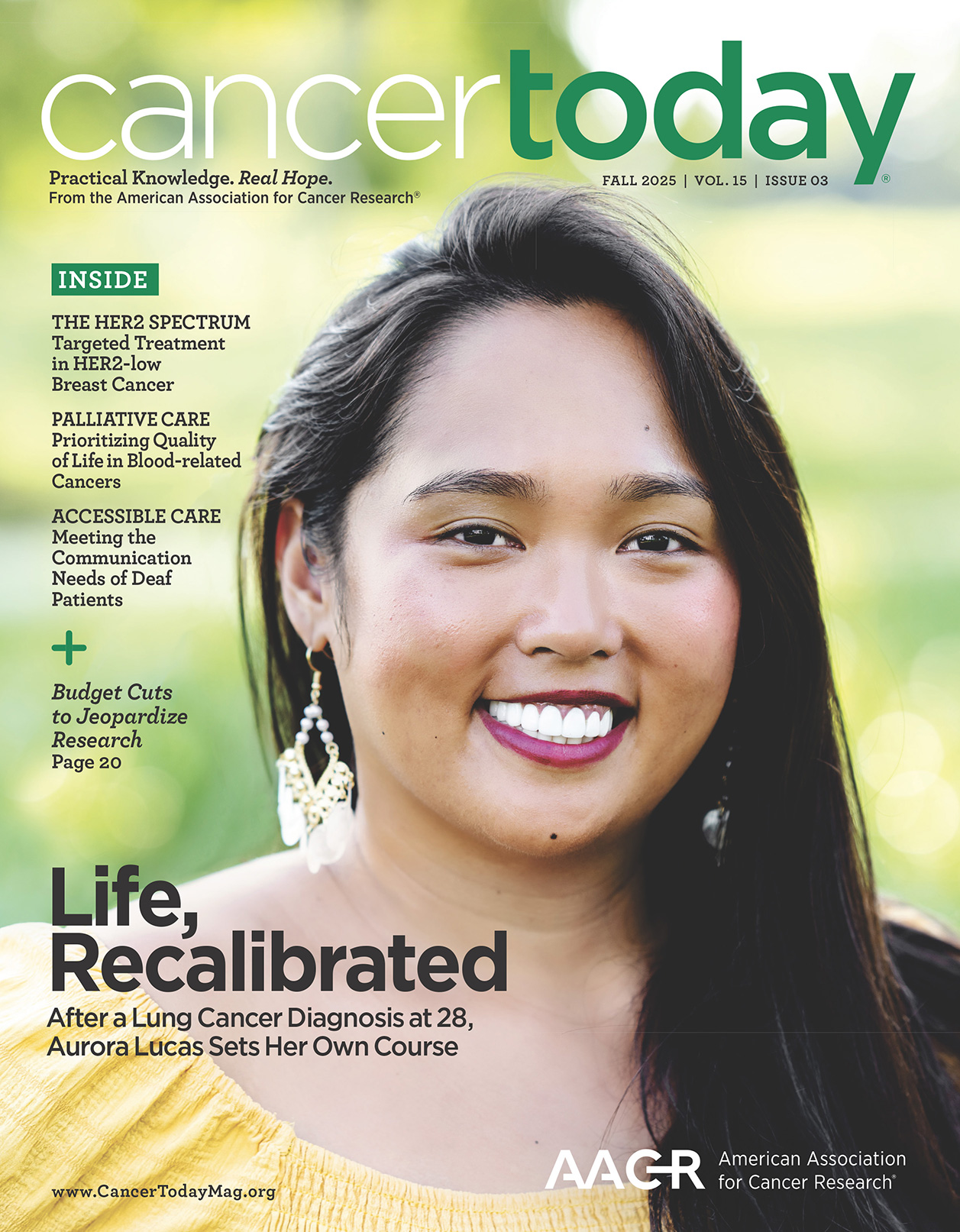CARA COOPER began experiencing fatigue in 2009 when she was 28 years old, first relatively mild but gradually escalating to near-constant exhaustion.
On her doctor’s recommendation, Cooper took vitamin supplements. She began running half and full marathons to bolster her fitness and energy. But her pace, never fast, became slower, and it was a labor just to propel herself forward. “It got to the point that I couldn’t even run down the street,” says the now 34-year-old graphic designer. “It felt like something was sucking the life out of me.”
In 2014, the Melbourne, Florida, resident switched to another medical practice, and the nurse practitioner there ran tests, including an endoscopy for what she speculated might be a bleeding ulcer. It wasn’t until December 2014—after six years of symptoms, two colonoscopies and various detours—that Cooper learned she had metastatic colon cancer that had spread to her liver.
In recent years, studies have offered evidence of a trend that colorectal cancer specialists fret about among themselves: A larger number of young adults like Cooper are appearing in their offices. Although the number of colorectal cancer cases diagnosed before age 50—the typical age to start screening—remains relatively small, younger individuals’ vulnerability to colorectal cancer appears to be increasing. If current trends persist, by 2030 the incidence rate of newly diagnosed patients between ages 20 and 34 will almost double, and among people 35 to 49 it will increase by 46 percent. During the same interval, the incidence rate is projected to decline by more than a third in adults 50 and older, according to data published in the January 2015 JAMA Surgery.
This increase among younger people of a malignancy most frequently diagnosed between ages 65 and 74 raises screening and treatment dilemmas, with more questions than answers. Given the lack of routine screening and perhaps a lack of awareness, colorectal cancer in younger adults might go undetected at earlier, more treatable stages, says Christopher Lieu, a medical oncologist at the University of Colorado Cancer Center in Aurora. Researchers and cancer specialists are also delving into whether these tumors are more aggressive or different in some other way from later-in-life malignancies. Early findings indicate that tumors could be more difficult to treat successfully in younger adults. For example, one small-scale genetic analysis that Lieu was involved in found signs that tumors among adults under 35 might be more resistant to chemotherapy.
Another study led by Lieu, this one published in the Sept. 20, 2014, Journal of Clinical Oncology, and based on data from 20,023 patients with metastatic colorectal cancer enrolled in clinical trials, found that mortality followed a U-shaped curve, with the youngest and oldest patients being most vulnerable. Despite their inherent vitality, the youngest adults faced a 19 percent higher risk of death compared with those in middle age, with the lowest risk among adults in their late 50s. The U-shaped curve began moving up again as patients grew older.
What’s Going On?
The number of early-onset colorectal cancer cases in the JAMA Surgery analysis is still relatively small, with just 3,815 cases, or 1 percent, detected prior to age 35, the group that Cooper falls into. An additional 6.8 percent, or nearly 27,000 adults, were diagnosed between ages 35 and 49. But the study—by looking at 36 years of data (1975-2010) totaling slightly more than 393,000 patients—projected future trends. If current patterns continue, by 2030 slightly more than one in 10 colon cancers and nearly one in four rectal cancers will be diagnosed before age 50, the researchers wrote.
“Despite low absolute numbers, the unscreened population is the only group in the U.S. where colorectal cancer is on the rise,” says Jason Zell, a medical oncologist at the University of California, Irvine, who took part in another study published last year that found a similar pattern among young adults in California.

Although the number of colorectal cancer cases diagnosed before age 50—the typical age to start screening—remains relatively small, younger individuals’ vulnerability to colorectal cancer appears to be increasing. Photo © OcusFocus / istock / Thinkstock
The majority of colorectal cancer diagnoses at any age are sporadic cases—diagnoses that can’t be linked to a family or genetic vulnerability. Since the tumors in younger adults emerge much earlier in life, it’s logical to assume that there are influences that more quickly transform normal cells into malignant cells, says Nancy You, a colorectal surgeon at the University of Texas M. D. Anderson Cancer Center in Houston. “My personal bias is that there is some kind of gene-environment interaction that makes these people higher risk,” she says. “I don’t think it’s all environment and I don’t think it’s all genes.”
Potential environmental factors might include increased obesity in the U.S. population and people making poor dietary choices, such as eating too many processed foods, You says. These trends are worth studying, but at this point they are “just theories,” she says. Genetics also appears to play a role, particularly in those who develop colorectal cancer before age 35, according to a study published online July 20, 2015, in the Journal of Clinical Oncology. The study, involving 193 colorectal cancer patients, looked for hereditary disorders such as Lynch syndrome and found that 35 percent of colorectal cancer patients younger than age 35 carried such a genetic risk. In the general population, the rate is 2 to 5 percent, according to the study.
Unfortunately, the tumors frequently aren’t caught in younger adults until they are more difficult to treat. In the Feb. 13, 2012, Archives of Internal Medicine, an analysis led by You found 63 percent of colon cancers and 57 percent of rectal cancers in adults younger than age 50 were diagnosed at stages III or IV. Among older adults, late-stage diagnoses were at slightly less than 50 percent.
One of the most common initial symptoms of colorectal cancer is blood on the toilet paper or in the bowl, You says. But adults in their 30s and 40s who notice bleeding might delay consulting a doctor. And the doctor might write it off to the far more common problem of hemorrhoids, until the patient complains about abdominal pain, obstruction and weight loss. “Unfortunately, those are such late-stage symptoms,” she says.
Cooper’s route to a diagnosis was particularly convoluted. Her first colonoscopy in August 2014 identified a tumor on the left side of her colon close to her rectum. A biopsy determined that it wasn’t malignant, but surgery was recommended. Even after recovering from the surgery, though, Cooper suffered “knife-stabbing” pain while going to the bathroom. She returned for another colonoscopy in December, which identified a two-inch tumor further up her colon on the right side of her abdomen.
Once that tumor was detected and soon after a CT scan found the two metastases to the liver, Cooper felt pressured to undergo surgery immediately. But she stalled, in part because she wasn’t happy with the recommendation of a gastroenterologist who advised that her entire colon be removed.
Plus, she says, “I kind of wanted the holidays to myself because I wasn’t sure at that point if it was curable, if it was beatable. And I wanted to enjoy the holidays.”
Not everyone should wait until age 50 to start screening for colorectal cancer.
Not everyone should wait until age 50 to start screening for colorectal cancer. Adults who fall into one of the following groups should talk to their doctor about an earlier test if:
- They have been diagnosed with adenomatous polyps, noncancerous growths in the colon or rectum.
- They have been diagnosed with an inflammatory bowel disease, such as ulcerative colitis or Crohn’s disease.
- One or more of their close family members (a parent or sibling) have been diagnosed with colorectal cancer, particularly if it was prior to age 60.
- They have family members with a genetic vulnerability such as Lynch syndrome, also known as hereditary nonpolyposis colorectal cancer (HNPCC).
Malignant Differences?
Because younger adults don’t receive routine colorectal cancer screening, the cancer might not be diagnosed as early as in older adults and might require more extensive surgery, You says. For example, a tumor in the rectum might invade part of the vagina or the prostate, requiring a portion of that area to be removed. But the surgical approach should be the same whether the patient is 35 or 65, if the cancer is believed to be a sporadic case that doesn’t have a genetic link, You says.
Neither should the chemotherapy recommended differ based on age, says Lieu. Some of the common drugs used to treat colorectal cancer include 5-fluorouracil (5-FU), irinotecan and oxaliplatin prescribed in various combinations, such as FOLFOX (5-FU, leucovorin and oxaliplatin) or FOLFIRI (5-FU, leucovorin and irinotecan). If radiation is recommended, it’s primarily for tumors that originate in the rectum, Lieu says.
Whether younger individuals respond equally well to the same chemotherapy drug is “a little bit controversial,” You says. She points to one analysis published in the July 10, 2011, Journal of Clinical Oncology showing results from nine chemotherapy trials that found no difference in overall survival between younger and older adults with advanced colorectal cancer. On the other hand, the U-shaped mortality curve identified by Lieu’s study shows that younger adults don’t always fare as well, despite their youthful vigor prior to being diagnosed, You says.
In the small genetic sequencing study of colorectal tumors that Lieu was involved in, the tumors in younger patients appeared to have more activated pathways involved with the metabolizing of 5-FU and irinotecan. One hypothesis, says Lieu, who wants to join with other facilities to study the tumors of a larger number of patients, is that the bodies of younger patients might clear the drugs more efficiently. If true, he says, the drugs might not linger long enough in a patient’s system to be most effective against the cancer.
Yet another outstanding question is whether doctors are overtreating younger patients with chemotherapy, You says. Patients under age 50 were two to four times more likely to get chemotherapy after surgery than individuals 65 to 75, according to a study that You co-authored in the May 2015 JAMA Surgery. That treatment difference extended to patients with stage I or II tumors, for whom chemotherapy after surgery is not the standard of care, the researchers wrote.
Despite risking the side effects of chemotherapy, such as numbness or tingling in the fingers, younger patients getting more aggressive multidrug treatments—sometimes outside the recommended standard of care—showed no significant survival gains compared with older patients getting fewer drugs, You says. “I think physicians in the community are sometimes uncomfortable when they see a young person with cancer,” she says. “It may also be partly driven by the patient themselves, that they want everything done.”
Cooper, who sought out a second opinion at Orlando’s Florida Hospital, had surgery in February 2015. During the nearly five-hour operation, a colorectal surgeon and a liver specialist worked side by side, removing roughly 60 percent of her colon and 20 percent of her liver. Her doctors were hopeful that they removed all of the malignant tissue, Cooper says.
Shortly afterward, Cooper began 12 cycles of the FOLFOX chemotherapy regimen in an attempt to eradicate any lingering cells and finished her treatments in August 2015. Medication has helped keep a lid on her nausea, which she describes as relatively mild, but she has faced fatigue and nerve-related effects. At work, the graphic designer often wears mittens to warm her hands and reduce numbness and tingling.
Cooper describes herself as upbeat and focused on getting beyond chemotherapy. “They don’t foresee it coming back, hopefully,” she says of her cancer. “Hopefully. I try not to say the ‘cancer-free’ word. I’m so superstitious. But they’re pretty confident.”
Cancer Today magazine is free to cancer patients, survivors and caregivers who live in the U.S. Subscribe here to receive four issues per year.





